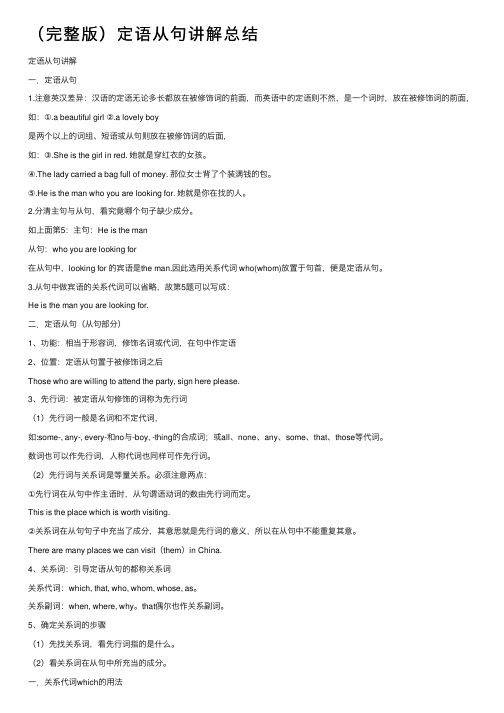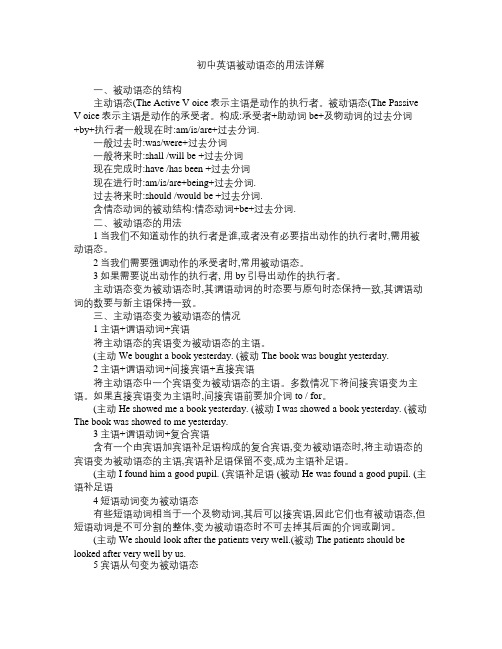专题一二定语从句及被动语态详解
- 格式:doc
- 大小:53.50 KB
- 文档页数:8

(完整版)定语从句讲解总结定语从句讲解⼀.定语从句1.注意英汉差异:汉语的定语⽆论多长都放在被修饰词的前⾯,⽽英语中的定语则不然,是⼀个词时,放在被修饰词的前⾯,如:①.a beautiful girl ②.a lovely boy是两个以上的词组、短语或从句则放在被修饰词的后⾯,如:③.She is the girl in red. 她就是穿红⾐的⼥孩。
④.The lady carried a bag full of money. 那位⼥⼠背了个装满钱的包。
⑤.He is the man who you are looking for. 她就是你在找的⼈。
2.分清主句与从句,看究竟哪个句⼦缺少成分。
如上⾯第5:主句:He is the man从句:who you are looking for在从句中,looking for 的宾语是the man.因此选⽤关系代词 who(whom)放置于句⾸,便是定语从句。
3.从句中做宾语的关系代词可以省略,故第5题可以写成:He is the man you are looking for.⼆.定语从句(从句部分)1、功能:相当于形容词,修饰名词或代词,在句中作定语2、位置:定语从句置于被修饰词之后Those who are willing to attend the party, sign here please.3、先⾏词:被定语从句修饰的词称为先⾏词(1)先⾏词⼀般是名词和不定代词,如:some-, any-, every-和no与-boy, -thing的合成词;或all、none、any、some、that、those等代词。
数词也可以作先⾏词,⼈称代词也同样可作先⾏词。
(2)先⾏词与关系词是等量关系。
必须注意两点:①先⾏词在从句中作主语时,从句谓语动词的数由先⾏词⽽定。
This is the place which is worth visiting.②关系词在从句句⼦中充当了成分,其意思就是先⾏词的意义,所以在从句中不能重复其意。

专题十八:定语从句一、定语从句:1.定语从句的概念:在复合句中,修饰某一名词或代词的从句叫定语从句。
2.先行词:被定语从句修饰的名词或代词叫先行词。
3.关系词:引导定语从句的连词叫关系词。
如that、which、who、whom、whose、where、when等。
4.由that、which、who、whom、whose引导的定语从句。
关系词指代在定语从句中的作用that既指人也指物作主语、宾语which指物作主语、宾语who指人作主语whom指人作宾语whose既指人也指物作定语二、定语从句:1.先行词是物时,一般情况既可用that,which均可.但下列情况,只用that不用which。
1).当先行词为指物的不定代词,如all、everything、something、anything、nothing、none、the one等时,只能用that。
There is nothing ______ I can do for you .2).先行词被the only, the very, the last, all, no, little等词修饰,只用that。
This is the very book ___ I’m looking for .3).先行词被序数词修饰时,只用that . This is the first nextbook ______ I studied in the middle school .4).先行词为最高级或被最高级修饰时,只能用that。
This is the most beautiful mountain ______ I have ever seen .=I have _____ seen _____ a beautiful mountian .5).先行词既有人也有物时,只能that 。
He told us many interesting things and persons _______ we had .2.先行词是物时,一般情况既可用that也可用which.但下列情况,只能用which不用that。


初中英语被动语态的用法详解一、被动语态的结构主动语态(The Active V oice表示主语是动作的执行者。
被动语态(The Passive V oice表示主语是动作的承受者。
构成:承受者+助动词be+及物动词的过去分词+by+执行者一般现在时:am/is/are+过去分词.一般过去时:was/were+过去分词一般将来时:shall /will be +过去分词现在完成时:have /has been +过去分词现在进行时:am/is/are+being+过去分词.过去将来时:should /would be +过去分词.含情态动词的被动结构:情态动词+be+过去分词.二、被动语态的用法1当我们不知道动作的执行者是谁,或者没有必要指出动作的执行者时,需用被动语态。
2当我们需要强调动作的承受者时,常用被动语态。
3如果需要说出动作的执行者, 用by引导出动作的执行者。
主动语态变为被动语态时,其谓语动词的时态要与原句时态保持一致,其谓语动词的数要与新主语保持一致。
三、主动语态变为被动语态的情况1主语+谓语动词+宾语将主动语态的宾语变为被动语态的主语。
(主动We bought a book yesterday. (被动The book was bought yesterday.2主语+谓语动词+间接宾语+直接宾语将主动语态中一个宾语变为被动语态的主语。
多数情况下将间接宾语变为主语。
如果直接宾语变为主语时,间接宾语前要加介词to / for。
(主动He showed me a book yesterday. (被动I was showed a book yesterday. (被动The book was showed to me yesterday.3主语+谓语动词+复合宾语含有一个由宾语加宾语补足语构成的复合宾语,变为被动语态时,将主动语态的宾语变为被动语态的主语,宾语补足语保留不变,成为主语补足语。


定语从句语法专题(Attributive Clauses)教案一. 定语从句的概述:1.定语从句:在复合句中,修饰某一名词或代词的从句叫定语从句。
在句中做定语,被修饰的名词或代词,叫做先行词。
从句通常放在先行词之后,由关系词(关系代词或关系副词)引导。
其作用是作定语修饰主句的某个名词性成分,相当于形容词,所以又称为形容词性从句,一般紧跟在它所修饰的先行词后面。
eg She is the girl(who got the first prize.)girl先行词who充当从句主语, 从句做定语修饰girlThis is the boy who broke the window.这就是打破窗子的孩子。
the boy是先行词, who broke the window是限制性定语从句, 明确指出theboy是打破窗子的那个孩子,who 在从句中充当主语That is the house where he lived ten years ago.He is the man who/that lives next door.He is the man who I want to see.先行词关系词定语从句复合句: 是由一个主句和一个或一个以上的从句构成的句子, 复合句中的主句和从句都具有完整的的主语和谓语, 主句是复合句的主体, 可以独立存在, 从句需要有一个连词引导, 是修饰说明主句的, 不能独立存在, 根据在句中的不同作用, 从句可以分为三类: 定语从句, 名词性从句, 状语从句。
二. 引导定语从句的关系词有两大类:1.关系词:引导定语从句的关联词称为关系词,关系词有关系代词和关系副词。
关系代词: that, who, whom, whose, which, as(主, 宾, 定)关系副词: when, where, why.(状语)2.关系词的作用:(1)引导定语从句, 在先行词和定语从句之间起连接作用;(2)代替先行词在句中充当成分。
中考英语主动语态变被动语态被动语态由“助动词+及物动词的过去分词”构成。
不同时态的被动语态的差异主要体现在助动词be的变化上,同时助动词be还要在人称和数上与主语保持一致。
在将主动语态变为被动语态时,可按以下三个步骤:a.把主动语态的宾语变为被动语态的主语。
b.把谓语变成被动结构(be+过去分词) ,并根据被动语态句子里的主语的人称和数以及原来主动语态句子中动词的时态来决定be的形式。
c.把主动语态中的主语放在介词by之后作宾语,将主格改为宾格。
在无须说明动作的执行者或只强调动作的承受者时,by短语可以省略。
例如:All the people laughed at him. →He was laughed at by all people.They make the bikes in the factory. →The bikes are made by them in the factory.含有双宾语的主动句改为被动句时,应将其中一个宾语改为被动结构的主语,另一个宾语仍保留在原处。
一种情况是把间接宾语(指人)变为主语,直接宾语(指物)不变;另一种情况是把直接宾语(指物)变为主语,间接宾语(指人)不变,这时,间接宾语前通常加介词to,有时加for。
例如:My father gave me a new book on my birthday.→I was given a new book (by my father) on my birthday. (间接宾语作了主语)→A new book was given to me (by my father) on my birthday. (直接宾语作了主语)含有情态动词的主动句变成被动句时,由“情态动词+be+过去分词”构成,原来带to的情态动词变成被动语态后,to仍要保留。
例如:We can repair this watch in two days.→This watch can be repaired in two days.They should do it at once.→It should be done at once.练习将下列句子变为被动语态:1. We often sing this song._______________________________2. He broke his leg in the match._______________________________3. She will sell her house soon._______________________________4. He is repairing the machine._______________________________5. He has finished his work._______________________________6. We call him Lao Wang._______________________________7. We must do something to help her._______________________________8. What did you say at the meeting?_______________________________9. He gave me some old magazines._______________________________10. He told me to wait at the gate._______________________________【参考答案】1. This song is often sung.2. His leg was broken in the match.3. Her house will be sold soon.4. The machine is being repaired.5. His work has been finished.6. He is called Lao Wang.7. Something must be done to help her.8. What was said at the meeting?9. I was given some old magazines.10. I was told to wait at the gate。
英语被动语态用法归纳总结一、被动语态定义和用法当我们要突出某个行为的执行者时,应使用主动语态来表达,而要强调动作的承受者时,就要使用被动语态来表达。
主语为动作的执行者时,表示主动语态。
e.g. He told the story. (主动语态)他讲了这个故事。
主语为动作的承受者时,表示被动语态。
e.g.The story was told by him. (被动语态)这个故事被他讲了。
二、一般现在时被动语态的各类句式总结如下:1. 肯定句:主语+am / is / are+动词过去分词(+by+动作执行者)2. 否定句:主语+ am / is / are not+动词过去分词(+by+动作执行者)3. 一般疑问句:Am / Is / Are +主语+动词过去分词(+by+动作执行者)4. 特殊疑问句:特殊疑问词+ am / is / are + 主语+动词过去分词(+by+动作执行者)e.g. This song is still loved by many young people today.这首歌现在仍然受到许多年轻人的喜爱。
(肯定句)This camera is not made in Japan.这部相机不是日本制造的。
(否定句)—Is the film called Snow White?这部电影是叫《白雪公主》吗?(一般疑问句)—Yes, it is. / No, it isn’t. 是的。
/不是。
—How many people were mentioned in the conversation?(特殊疑问句) 对话中提到了几个人?—Two. 两个。
三、一般过去时的被动语态被动语态的动词形式为:be+动词的过去分词,其中be为助动词,根据不同的人称和时态有形式的变化。
因此,一般过去时的被动语态为:1. 肯定句:主语+was/were+动词过去分词(+ by+动作执行者)e.g. The letter was written by Jim.2. 否定句:主语+was/were not+动词过去分词(+ by+动作执行者)e.g. The letter wasn’t written by Jim.3.一般疑问句:Was/Were+主语+动词过去分词+(by+动作执行者)e.g. Was the letter written by Jim?4. 特殊疑问句:特殊疑问词+was/were+主语+动词的过去分词+(by+动作执行者)e.g. When was the letter written by Jim?当动词不定式作宾语补足语时,要把主动语态中表人的直接宾语变为被动语态的主语,宾语补足语的位置不变。
专题—定语从句(一)定义及相关术语1.定语从句:修饰某一名词或代词的从句叫定语从句。
定语从句一般紧跟在它所修饰的先行词之后。
2.先行词:被定语从句修饰的词叫先行词。
3.关系词:引导定语从句的词叫关系词。
关系词有关系代词和关系副词。
关系代词有that, which, who, whom, whose, as等;关系副词有when, where, why等。
关系词通常有下列三个作用:A、引导定语从句;B、代替先行词;C、在定语从句中担当一个成分。
例如:The man who is shaking hands with my father is a policeman. 该句中,who is shaking hands with my father 是定语从句,修饰先行词the man,“who”是引导定语从句的关系词,代替先行词the man,在定语从句中作主语。
(二)关系代词引导的定语从句1.who 指人,在定语从句中作主语。
The boys who are playing football are from Class One. 正在踢足球的男孩是一班的。
Those who want to go to the museum must be at the school gate at 7 tomorrow morning. 想去博物馆的人必须在明晨7点到大门口集合。
Yesterday I helped an old man who had lost his way. 昨天我帮助了一位迷路的老人。
That is the teacher who teaches us physics. 那就是教我们物理的老师。
2.whom 指人,在定语从句中做宾语,常可省略。
Mr Liu is the person ( whom ) you talked about on the bus. 刘先生就是你们在公共汽车上谈论的那个人。
Li Ming is just the boy ( whom ) I want to see. 李明正是我想要见的男孩。
The professor ( whom ) you are waiting for has come. 你正在等的教授已经来了。
The girl ( whom ) the teacher often praises is our monitor. 老师经常表扬的那个女孩是我们的班长。
注意:关系代词whom 在口语或非正式文体中常可用who 来代替,也可省略。
The man ( whom / who )you met just now is my old friend.3.Which 指物,在定语从句中做主语或宾语,做宾语时常可省略。
Football is a game which is liked by most boys. 足球是大多数男孩所喜欢的运动。
The factory which makes computers is far away from here. 制造计算机的那家公司离这儿很远。
He likes to read books which are written by foreign writers. 他喜欢外国作家写的书。
The house which is by the lake looks nice. 湖边的那幢房子看上去很漂亮。
This is the pen ( which ) he bought yesterday. 这是他昨天买的钢笔。
The film ( which ) they went to see last night was not interesting at all. 他们昨晚看的电影一点意思也没有。
4.That 指人时,相当于who 或whom;指物时,相当于which.。
在定语从句中作主语或宾语,作宾语时常可省略。
The number of people that / who come to visit this city each year reaches one million. 每年来参观这座城市的人数达一百万。
Where is the man that / whom I saw this morning? 我今天早上看到的那个人在哪儿?The person that /whom you introduced to me is very kind. 你介绍给我的那个人很友好。
The season that / which comes after spring is summer. 春天以后的季节是夏季。
Yesterday I received a letter that / which came from Australia. 昨天我收到了一封来自澳大利亚的信。
5.Whose 通常指人,也可指物,在定语从句中做定语。
I visited a scientist whose name is known all over the country. 我拜访了一个全国知名的科学家。
He has a friend whose father is a doctor. 他有一个爸爸当医生的朋友。
I once lived in the house whose roof has fallen in. 我曾经住在那幢屋顶已经倒塌了的房子里。
注意:指物时,常用下列结构来代替:The classroom whose door is broken will soon be repaired.The classroom the door of which is broken will soon be repaired.Do you like the book whose cover is yellow?Do you like the book the cover of which is yellow?(三)“介词+关系代词”引导的定语从句关系代词在定语从句中作介词宾语时,从句常常由“介词+关系代词”引出。
The school (which / that) he once studied in is very famous.The school in which he once studied is very famous. 他曾经就读过的学校很出名。
Tomorrow I’ll bring here the magazine (which / that) you asked for.Tomorrow I’ll bring here the magazine for which you asked.明天我将把你要的杂志带来。
This is the boy (whom / who / that) I played tennis with yesterday.This is the boy with whom I played tennis with yesterday. 这是我昨天跟他打台球的男孩。
We’ll go to hear the famous singer (whom / who / that) we have often talked about.We’ll go to hear the famous singer about whom we have often talked.我们将去听那位我们经常谈论的著名歌唱家演唱。
The manager whose company I work in pays much attention to improving our working conditions. The manager in whose company I work pays much attention to improving our working conditions. 我工作的那家公司的经理十分注意改善我们的工作条件。
注意:1.含有介词的短语动词一般不拆开,介词仍放在短语动词的后面。
如:look for, look after, take care of 等。
This is the watch (which / that) I am looking for. (正) 这是我正在找的手表。
This is the watch for which I am looking . (误)The babies (whom / who / that) the nurse is looking after are very healthy. (正) 那个保姆照看的小宝宝们都很健康。
The babies after whom the nurse is looking are very healthy. (误)2.若介词放在关系代词前,关系代词指人时只可用whom,不可用who, that;关系代词指物时只可用which,不可用that。
关系代词是所有格时用whose。
The man with whom you talked just now is my neighbour. (正) 你刚才跟他谈话的那个人是我的邻居。
The man with that / who you talked just now is my neighbour. (误)The plane in which we flew to Canada was really comfortable. (正)我们去加拿大所乘坐的飞机实在很舒服。
The plane in that we flew to Canada was really comfortable. (误)3.“介词+关系代词”前还可有some, any, none, all, both, neither, many, most, each, few等代词或者数词。
如:He loves his parents deeply, both of whom are very kind to him. 他深深地爱着他的父母,他们俩待他都很好。
In the basket there are quite many apples, some of which have gone bad. 篮子里有好些苹果,有些已经坏了。
There are forty students in our class in all, most of whom are from big cities. 我们班总共有40个学生,大多数来自大城市。
Up to now, he has written ten stories, three of which are about country life. 迄今为止,他写了10部小说,其中3部是关于农村生活的。